Midday Massacre
Gunfire, deaths shock lunch crowd
In less than an hour, he would be lying face up on a greasy, spit-stained curb. His clothes twisted. Blood pooling on his silk shirt. A crowd of hard men with rolled-up sleeves staring down at him.
But at noon, John Volpe was clean and dapper as he entered Frank Manna’s barbershop at 527 Fifth Ave. in Downtown Pittsburgh. Volpe settled into a chair. A shave and a shoeshine. The usual. Volpe was here every day. On Saturdays, he would plop down $2.25 and get a haircut and manicure, too. But not today. This was Friday, July 29, 1932.
At some point, Charles Modarelli entered the place. Modarelli was a former numbers racketeer from Squirrel Hill. He had fallen on hard times and needed money. Maybe, he thought, Volpe would loan him some cash.
Times were indeed tough. The full weight of the Great Depression pressed down on the nation’s chest. Pittsburgh was getting hammered. Roughly a third of Allegheny County’s workers were unemployed. Volpe, however, seemed to be doing fine. He always had a wad of cash. And, in an age lacking an economic “safety net,“ he was known to help those in need.
But on this day Modarelli was out of luck. “I’m pretty well cleaned out myself,” Volpe told him. “I just fixed up a mortgage of $2,600 for a widow.”
Modarelli may have been disappointed, but he stuck around.
Once the barber’s work was finished, Volpe rose from the chair. Though not a big man — he stood 5 feet 5 inches tall and weighed 175 pounds — Volpe cut a striking figure. At age 38, he was smooth-faced and dressed in a blue-gray summer suit, a white silk shirt with brown stripes, a black bow tie, and a brown and white woven belt. Hanging from his pocket was a watch fob adorned with 25 diamonds forming his initials, “J.V.” On his shirt, he wore a diamond-encrusted stick pin; a 6-carat diamond ring adorned his right hand.
Volpe pulled out his wallet. He had nothing smaller than a $10 bill. That’s when Joe Tito stepped forward. He was a racketeer, too. “I’ll pay the bill,” Tito said. That’s what he told police, anyway. Like the authorities, we’re forced to rely on the words of men who earned money by breaking the law.
Together, Volpe and Modarelli left the shop, situated directly across the street from the massive stone walls of the Allegheny County Courthouse, Western Pennsylvania’s most imposing symbol of justice.
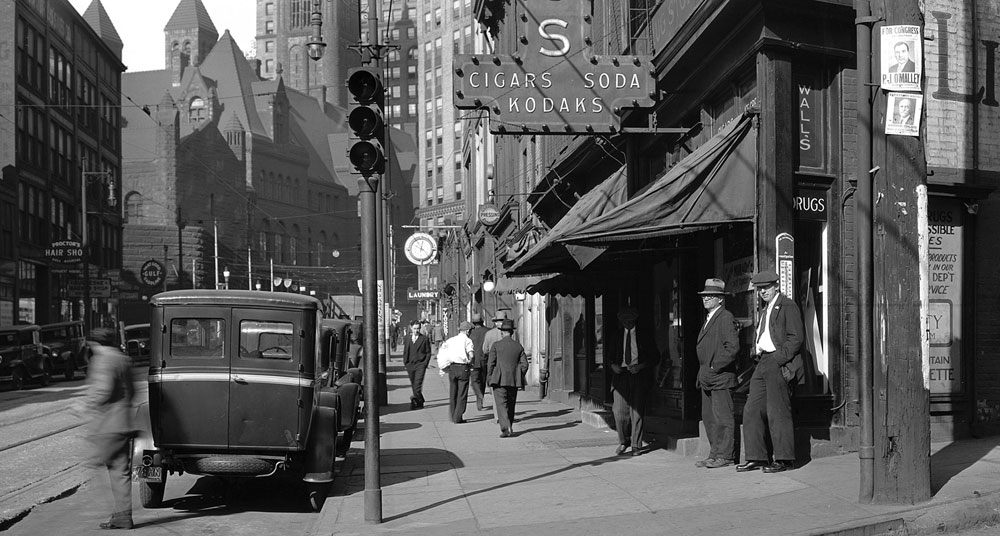
Its presence likely didn’t faze Volpe. He had friends and allies in that building. Over the years, Volpe had been arrested and charged a number of times for assault (he had been accused of beating up police officers, newspaper editors and fellow racketeers) and once for murder. But he had never been convicted.

Other members of the Volpe family weren’t so untouchable. At that very moment, in fact, John’s brother Louis was lodged in the Allegheny County Jail, one block away. Louis Volpe was serving a few months on a bootlegging conviction.
By now, the sidewalk along Fifth Avenue would have been filled with clerks, lawyers, secretaries, government officials, politicians and bureaucrats headed to lunch, running errands or just enjoying a pleasant stroll. Weather on this midsummer day was splendid — the temperature would rise no higher than the mid-70s.
The two men walked for half a block or so, then entered a drugstore. There, John Volpe, a man who had made a fortune selling bootleg booze, bought himself a milkshake.
They crossed over to Wylie Avenue and continued northeast. Here they entered a neighborhood of aging storefronts occupied by pawn shops, grocery stores, restaurants, barber shops and laundries. Residents were mostly Italian immigrants squeezed into second- and third-floor apartments. They had names like Sorrenti, Densensi and Copadanno and worked as laborers, shoemakers and tailors.
The neighborhood, part of the city’s Lower Hill District, was familiar with violence. Several months earlier, a racketeer named Jack Palmer (or Palmere) was chatting with a friend in front of a grocery store at 717 Wylie Ave. when a gunman walked up, aimed a pistol at Palmer’s head and fired. The murder remained unsolved.
At the moment, the street was peaceful. Streetcars clanged along the avenue; automobiles rumbled on the cobblestones
Volpe and Modarelli arrived at the Rome Coffee Shop, at 704 Wylie, and that’s where they parted. Modarelli went wherever hard-luck numbers men go at midday, and Volpe entered the coffee shop, which served as headquarters for his racket operations.
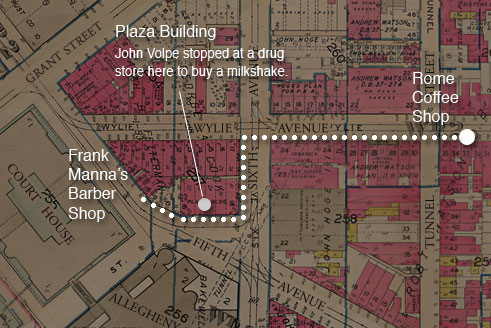
Newspapers described the shop as “dingy.” Its condition is difficult to discern from the few surviving pictures of the interior, since they focus mainly on bullet holes, broken plates and blood. But looking closely, we can see the shop’s scuffed wood floors, its small, round tables and stiff, wood chairs. Cigars are displayed in a glass case in the shop’s front room. On a steel counter is a large, ornate coffee urn. Ashtrays rest on tables in the back room.
Inside were James and Arthur Volpe, two of John’s six remaining brothers. James, 32, was a bit taller and heavier than his older brother John. And while he was not as dapper, his clothes still stood out in tough times: a gray-and-black suit with a brown striped shirt and a black-and-white tie. Arthur was taller than either of his brothers — lying on a slab at the coroner’s office, he measured slightly more than 5-9. Arthur wore a white shirt, brown trousers and tan shoes.
Pittsburgh had never before seen anything like the Volpe brothers. By 1932, they had become a dominant force in the deadly business of supplying alcohol to Pittsburghers who had been told a dozen years earlier they must do without. Prohibition by 1932 had proved a failure in most respects, but it had provided an excellent money-making opportunity for ruthless and organized men. Few in Pittsburgh were more organized, ruthless and successful than the Volpes.
The House of Volpe, as the newspapers sometimes called the organization, had recently lost one of its members. Young Chester Volpe was killed in a New Year’s Eve auto smash-up at Ninth Street and Penn Avenue. Newspapers claim that Chicago gangster Al Capone sent the family condolences and a massive $300 floral bouquet.
In the coffee shop with James and Arthur Volpe were a half-dozen of the gang’s “henchmen.” They had taken off their jackets and hats and were lounging and playing cards. One was a man named Santo Bazzano, brother of the shop’s owner.
John Volpe remained in the shop briefly, perhaps checking in with his brothers, then stepped back outside and onto the sidewalk along Wylie Avenue.
Shortly before 12:45 p.m., a dark blue Ford sedan motoring along Wylie Avenue pulled to the curb and stopped near the coffee shop. Three men wearing business suits climbed out of the vehicle.
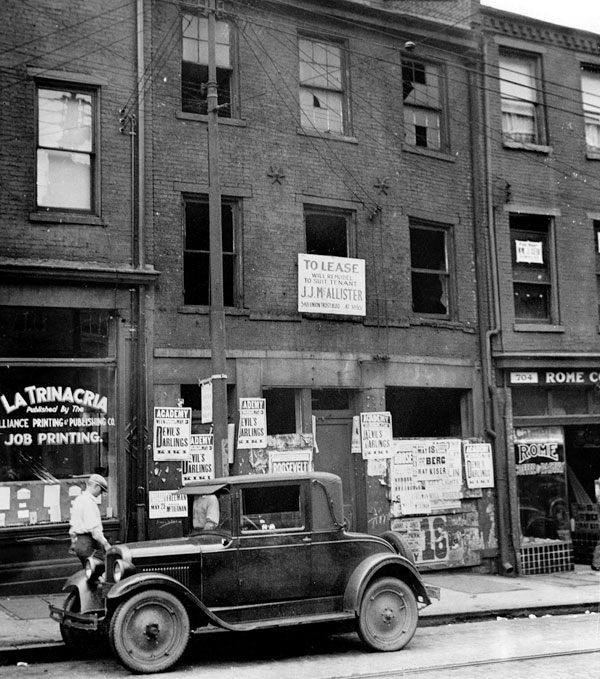
The Rome Coffee Shop, right, on Wylie Avenue. (Archives Service Center / University of Pittsburgh)
Witnesses would later claim one of the three was a large man with bushy eyebrows. This was Giuseppi Spinelli (newspapers sometimes spelled his name Spinello), a former Volpe friend and bodyguard. People knew him as “Big Mike.”
The other two were smaller men, and their identities remain uncertain. All three men carried pistols, either .32 or .38 caliber. They began walking toward the coffee shop.
At some point, John Volpe saw them. He must have recognized Spinelli and his intent, for John turned to flee, perhaps to his automobile, parked nearby. This was a logical move. Volpe drove a custom-designed light green 16-cylinder Cadillac coupe with bulletproof glass.
But Volpe was too late or too slow. One of the gunmen raised his weapon and fired.
Pedestrians on the street were at first confused. One man heard the popping noise and assumed an automobile was backfiring — a common occurrence in the early 1930s. Then the man looked up and saw Volpe staggering down the sidewalk.
Another witness, Paul Pischke, had just finished lunch at a Wylie Avenue restaurant and was headed back to his job in the City-County building when the shooting started. He heard the gunfire and looked up to see Volpe fall to his knees. According to newspaper accounts, Volpe collapsed against a woman named Antoinette Ferarro (or Ferraro, depending on the account). She then fainted.
At least five times, gunfire crackled on Wylie Avenue.
Alarmed, Pischke took shelter in a nearby storefront. He maneuvered quickly on the crutches he had used since losing a leg while working in a Lawrenceville steel yard years earlier. In the confusion, Pischke felt something strike his left crutch. Later, he would look down and see a bullet lodged in the wood.
John Volpe fell near the curb. He had been shot five times from behind. One bullet broke his left arm, another ripped through his heart.

Arthur Volpe
Gunmen entered the coffee shop. James Volpe rushed for the safety of a steel counter but was downed by three bullets that struck the back of his head, one tearing off part of his face. Arthur Volpe, sitting at a small, round table in a back room, was shot twice in the back of the head. A cereal bowl crashed to the floor. Arthur Volpe had been eating a lunch of corn flakes.
Tables and chairs were knocked over as the half-dozen men who had been lounging in the shop dove for the exits. Santo Bazzano ducked behind a steel counter.
Two of the three assassins left the Rome Coffee Shop by the front door. The third exited through a back door and made his way through an alley. Within moments, the three were back inside the Ford sedan and headed east.
On the street outside the shop, someone yelled, “They killed one of the Volpes.”
Traffic on Wylie Avenue ground to a halt. Within moments, a crowd of hundreds clogged the street’s 700 block. Men in stiff straw hats stood on the bumpers of parked cars in order to get a better view. Police rushed to the scene. So did Grant Street politicians.
The Rev. Eugene McGuigan of St. Ann’s Catholic Church in Millvale was riding in a passing streetcar and saw the commotion. He jumped off and squeezed through the clot of people to administer last rites to the well-dressed man dying in a gutter.
At some point, a photographer from the Pittsburgh Sun-Telegraph made his way to the front of the crowd. Before him lay John Volpe, perhaps already dead, his fine clothes twisted and blood-stained, a group of men gathered closely behind him. The photographer raised his bulky camera and snapped a picture of the gruesome scene.
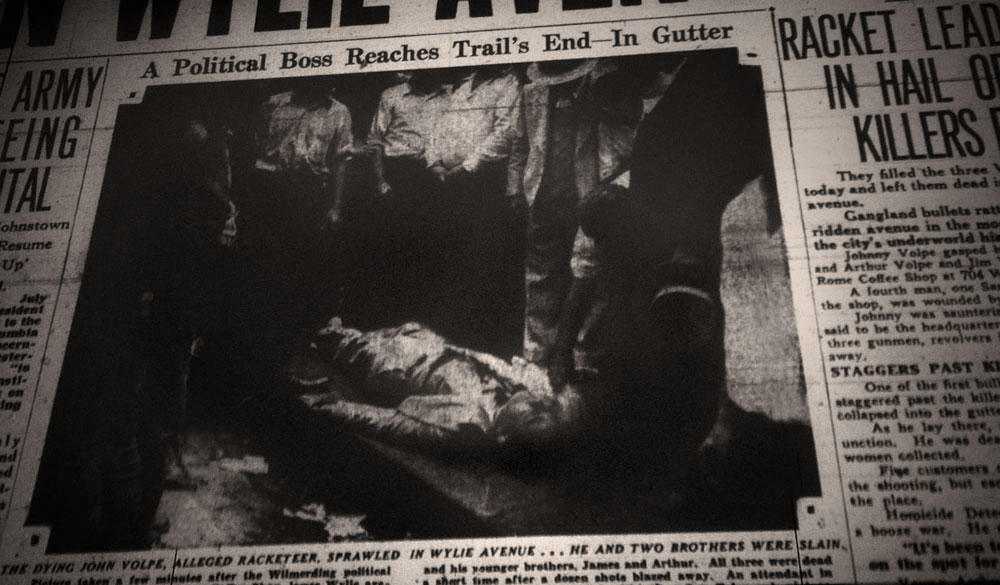
Bloody era, bold characters
The Volpe brothers were well-connected, politically influential and often-feared underworld bosses, and their midday assassinations on a busy city street, just a few blocks from the courthouse, shocked Pittsburgh and marked the beginning of the end of what was perhaps the most violent and corrupt era in the city’s history.
During Prohibition, Pittsburgh was home to a handful of colorful and often shamelessly bold crooks and characters who supplied illegal booze to a city that loved its beer and whiskey. Bootlegging was a profitable business. Its practitioners often drove expensive cars and wore flashy clothes in a time when many people had trouble paying rent. They also tended to get shot, stabbed, strangled, blown up, their bodies stuffed in barrels and burlap sacks and, on at least one occasion, decapitated.
Particularly dark and bloody was a five-year period that began in 1927 and ended in 1932. Gangsters were slain on street corners, in front of hospitals, in homes and in cars. And the killers? Well, let’s just say justice took an extended holiday. The Pittsburgh Press, which was keeping score, noted that the Volpe killings brought the number of unsolved gang murders in the city to 100.
That era came to an official conclusion on Dec. 5, 1933, with ratification of the 21st Amendment. Liquor once again became legal. Bootleggers (those who survived, that is) were forced to find other ways of making money.
So if you raise a glass to celebrate the 80th anniversary of Prohibition’s demise, remember also the passing of John, James and Arthur Volpe. And of dozens of other Pittsburghers with names like Monastero, Siragusa and Lamendola. They were our Al Capones, our Lucky Lucianos. They came to violent ends in an attempt to illegally supply our forebears with booze.
Dry laws, wet town
When the 18th amendment was ratified on Jan. 16, 1919, The Press roared in large black type, “U.S. IS VOTED DRY.” In those early years of Prohibition, however, enforcement of liquor laws in Pittsburgh was disorganized and random. “Dry agents” were often corrupt or incompetent or both. Besides, drinking here was a tradition.
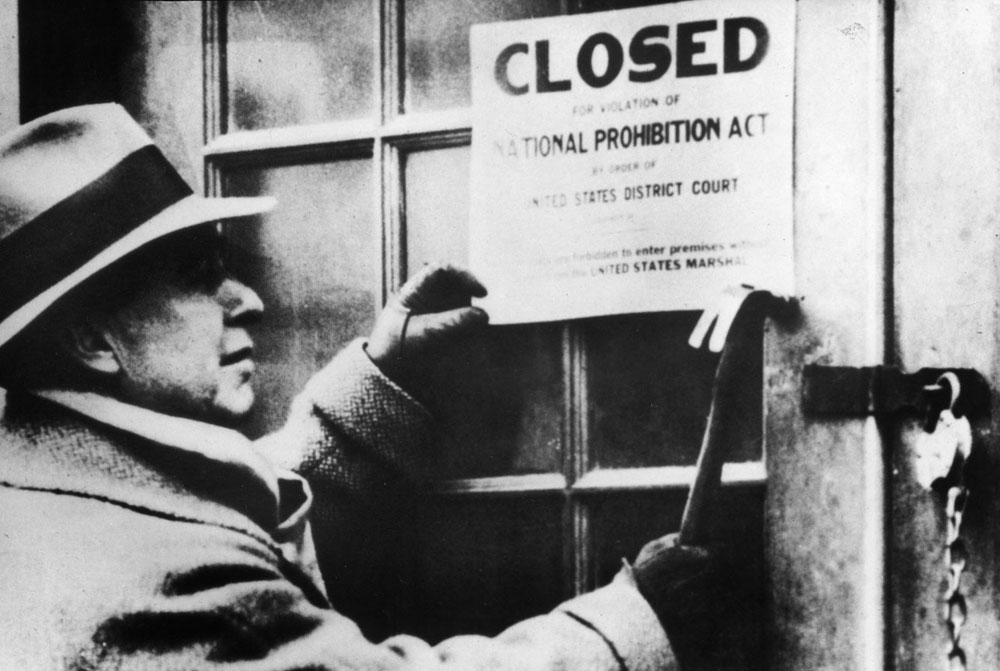
And illegal booze joints? They, too, were a Pittsburgh tradition. Speakeasies had thrived in Pennsylvania since 1887, when the state adopted a law that made it prohibitively expensive to obtain a saloon license. Within three years, Pittsburgh boasted 2,500 illegal taverns, many of which operated so openly that one newspaper declared, “These are not ‘speakeasies’ but ‘yell-outs.’”
The authorities weren’t inclined to bother bootleggers. Police were known at the time to take a sip of booze themselves, even while on the beat — until the city’s police chief ordered the patrolmen to knock it off. That seemed a bit unfair to one newspaper. The drinking ban, it noted, was “harsh, in that an employee might be ill, or might need an occasional ‘bracer’ to bring his efficiency up to the usual standards.”
And so you can imagine what happened when Prohibition became the law of the land. Pittsburghers didn’t stop drinking; they simply got creative in how they obtained alcohol.
Desperate drinkers were known to drain the radiators of automobiles parked on the Mon Wharf — at the time, alcohol was used as a motor coolant. The fluid was captured in a can, and a potato was inserted to purify the alcohol. This was a tricky proposition. If the potato was removed too soon, the alcohol could be deadly.
Others found it easier and safer to visit one of the city’s estimated 2,000 speakeasies. Such places, though illegal, were easy to find. Police and politicians turned a blind eye — for a price. Corruption was rampant. It seemed as though everyone, from the beat cop to the city’s mayor, was on the take.
Pittsburgh in the 1920s and ’30s was a crowded, dirty place. The city was home 669,000 people, making it the 10th largest metropolis in the United States in 1930 (today, the city ranks 61st with a populations of slightly more than 300,000). Train sheds, railroad tracks and industrial facilities jammed what is now tree-filled Point State Park. Greenery didn’t stand a chance. Steel mills, freight yards and gas storage tanks dominated the riverfronts.
Many residents were immigrants who clustered in densely packed neighborhoods, often hard against steel mills, forges, factories and railroad tracks
The promise of opportunity had lured these people to Pittsburgh, and so they worked — often as laborers in mills and factories, where jobs were difficult and dangerous. They were often met with hostility from residents who felt threatened by their different languages or religious affiliations. Protestants, firmly entrenched in the region’s power structures, sometimes feuded openly with Catholics.
Leading the most strident anti-Catholic charge was the Ku Klux Klan, which grew rapidly in Pennsylvania in the mid 1920s. The Klan often staged large demonstrations and were experts in intimidation — at times, staging as many as 50 cross burnings a night across the state. In 1923, white-hooded Klansmen caused a riot in Carnegie, which had a strong Catholic presence. Three years later, more than 8,000 white-sheeted Ku Klux Klan members marched through the streets of Wilkinsburg, clogging streets all the way to Pittsburgh’s East Liberty neighborhood.
Such displays reminded immigrants of their powerlessness and vulnerability. Prohibition provided an opportunity to even the playing field — if just a bit. Immigrants who were skilled in organizing and garnering support, and who were unafraid of violence, could gain power and money by going into the bootleg business. They got plenty of help from corrupt Grant Street officials and lawmen.
In this atmosphere, booze joints thrived.
'City's greatest manhunt'
Police entering the Rome Coffee Shop in the moments after the guns fell silent found the place a shambles. “Bullet holes dotted the walls,” The Press reported. “A counter had been pushed over. Tables were on their sides. In the back room, where Arthur Volpe fell, a dish, shattered by a bullet, lay upon the floor.” Arthur’s package of corn flakes remained on a table.
James Volpe lay in the front room. The half-dozen henchmen who had been lounging in the coffee shop apparently bolted without taking time to collect their hats and jackets. Police found one witness — Santo Bazzano. He was crouched under a counter, crying “I don’t wanna be shot, I don’t wanna be shot.”
Outside, mounted police officers tried to disperse the crowd. The bodies of John Volpe and his brothers were scooped into police wagons and driven to Mercy Hospital, then to the morgue. Newsboys hawked afternoon editions, which were rushed off the presses. Gracing the front page of the Sun-Telegraph was the gruesome picture of John, lying mortally wounded on the sidewalk. “Gunmen slay 3 Volpes in Wylie Avenue shop,” the massive headline read. The Press blared simply, “Three Volpes slain.”
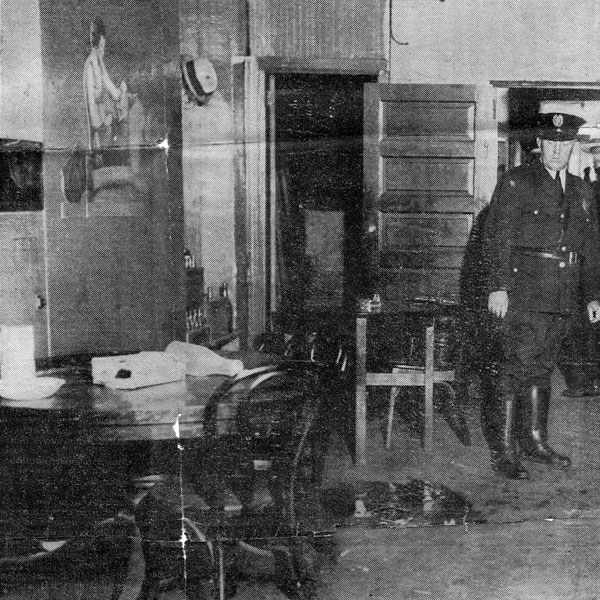
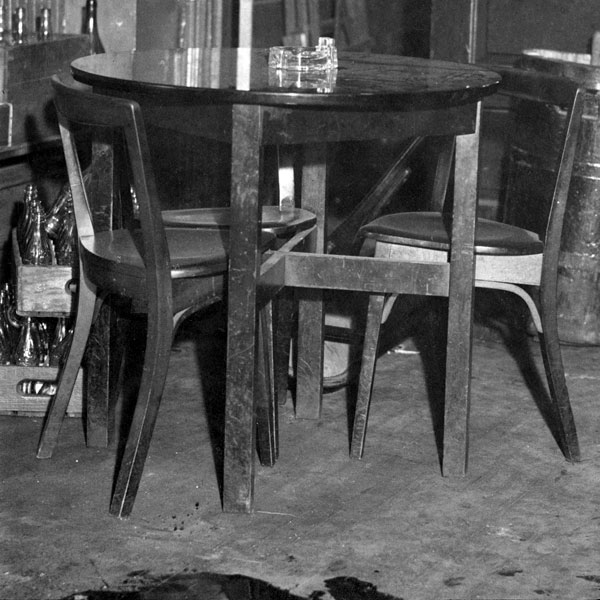
Click smaller image to see interior of the Rome Coffee Shop after shootings.
(Post-Gazette photos)
Police swarmed over Wylie Avenue, ransacking businesses and buildings in search of suspects and clues. It was no use. The killers had disappeared. All the police had was Santo Bazzano. He was handcuffed and taken away for questioning. Like everyone else in the city, police wanted to know who killed the Volpes, and why. Santo Bazzano insisted he had no idea who has put his pals “on the spot.”
Newspaper reporters were doing a bit of detective work of their own, scouring the lower Hill for witnesses. They fared no better than the police. Businessmen and residents were closed-mouthed.
“I heard the shots,” a nearby barber told The Press. “They sounded like cap pistols. I didn’t pay any attention.”
A druggist in the block said, “I heard the shots but I knew better than to go out.”
At the Allegheny County Jail three blocks away, Louis Volpe was visiting the inmate library when a late-edition newspaper arrived. Louis “blanched slightly” upon learning of his brothers’ demise, reported the Sun-Telegraph. Then Louis returned to his cell. Otherwise he showed no emotion. Later, Louis would request permission to attend his brothers’ funerals.
Those brothers by now were laid out on slabs at the Allegheny County Morgue. Pansee Volpe was summoned to identify the bodies. Poor Pansee — the widow of Chester Volpe, who had died months earlier in a car crash — was in no condition to undertake such a morbid task. She promptly collapsed.
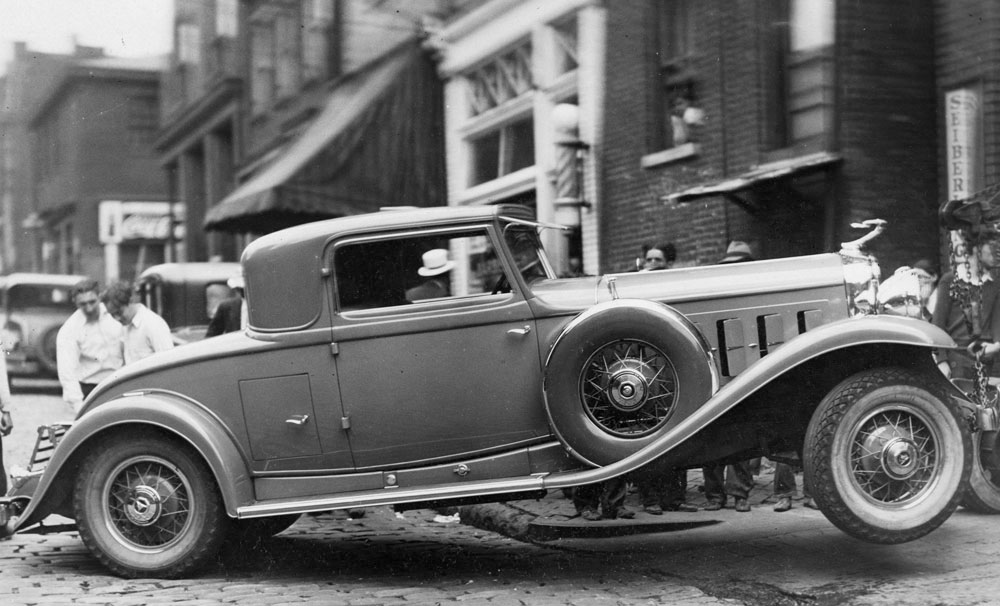
A tow truck was summoned to move John Volpe’s luxurious 16-cylinder Cadillac to a Webster Avenue garage for examination. The vehicle bore a “trick” license plate, which read “JV8” — a combination of John’s initials and the number of sons Ignazio and Rose Volpe had borne. How John obtained such a plate soon became a matter of great speculation in the press. Such custom plates were difficult to come by without substantial political connections.
The auto company that sold the vehicle to John was very interested in getting it back. John owed the company $7,500. Company owners, however, decided that driving the vehicle on city streets would be too dangerous. What if the Volpes’ killers were still in town, looking for other targets? Anyone driving John’s audacious vehicle could be a target. So the Cadillac remained for several days in the Webster Avenue garage.
Meanwhile, the city’s politicians were busy expressing outrage. Alderman John J. Verona, whose office was a block away from the coffee shop, declared, “I was shocked when I heard the boys were killed. They were my friends and gentlemen.”
Verona was well acquainted with the city’s mayor, Charles Kline. Kline, a Republican, was a dapper dresser who liked to greet visiting celebrities. Since taking office in 1926, he had stood proudly next to President Calvin Coolidge, aviator Charles Lindbergh, actress Mary Astor and boxer Gene Tunney. But this had been a bad year for the mayor. In May, he had been convicted of malfeasance in office and was facing a year in prison.
Kline was relaxing at his vacation home in Madison, Ohio, when news of the Volpe killings reached him. “The triple murder of the Volpe brothers is one of the most outrageous and brutal murder in the history of Pittsburgh,” he huffed. Kline declared he was taking personal command of the police department and directed that every available man be put on the case. Police superintendent Peter P. Walsh took the hint. The search for the killers would be “one of the city’s greatest manhunts,” he proclaimed.
The hunt for three assassins was on. Sort of.
Drinking, vice rampant in city
In the summer of 1926, the Pittsburgh Post dispatched reporters to the North Side, Hill District and East Liberty to see how openly bootleggers and gamblers were operating. The resulting stories and pictures, published over a three-day period, detailed the location of dozens of bars, “bawdy houses” and gambling dens. Names of owners were published, as were the names and titles of officials who protected the illegal businesses from raids.
The series made clear that authorities didn’t just turn a blind eye to the “vice houses” infesting some city neighborhoods, they patronized and protected them, and in some cases ran them.
Some of the joints found by the Post were low-end affairs. A speakeasy located at East and Milroy streets on the North Side served colored moonshine and “high test” beer. “The bar is filthy and in disorder,” the Post wrote. At 24 Cajou Way, an illegal tavern occupied a 10-by-12-foot room where an “unkempt bartender” ladled out moonshine “guaranteed to kill at 20 paces.”
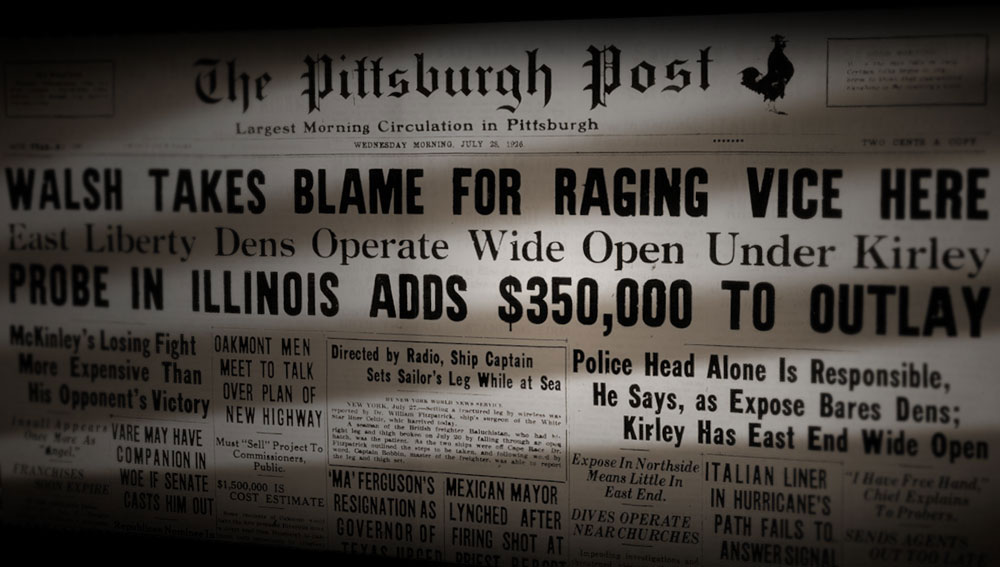
Not all speakeasies were dives. One reporter easily gained entry to a swanky “gambling and boozing kennel” on the third floor of the Kenyon Theatre on Federal Street. Guests sat in wicker settees and armchairs and listened to a Victrola playing music ranging from jazz to opera. It was a place of marble-top tables and expensive rugs. A highball cost 50 cents.
“Whiskey, gambling by means of a battery of slot machines, ‘shot’ beer and pool tables are the attractions,” the reporter wrote.
This noisy speakeasy with its open-door policy operated right under the nose of the law. In the basement of the same building were a pool hall and a bowling alley owned by a man named Charles Faulkner, police inspector for the North Side.
Vice on the North Side, 1926
Click the black icons below.See locations of vice. Take a closer look
Take a closer look
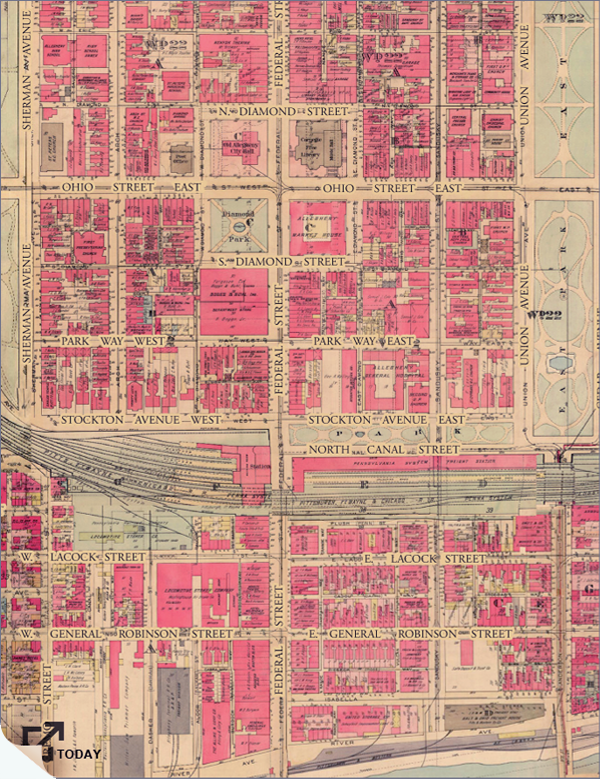

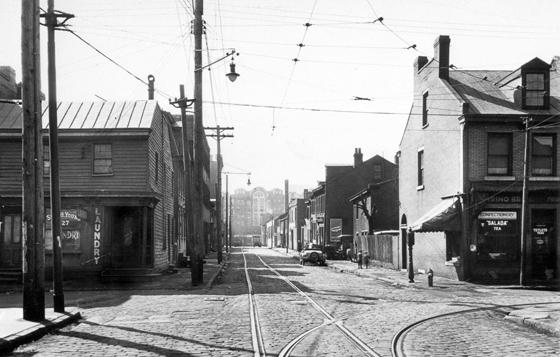
This corner was occupied in 1929 by a laundry and a candy store. (Archives Service Center/University of Pittsburgh).
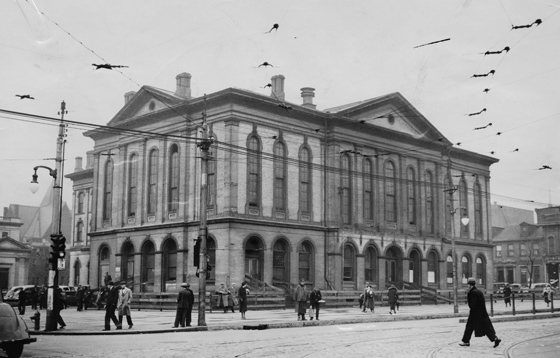
Shortly after this picture was taken in 1937, the old city hall at the intersection of Federal and Ohio streets was demolished to make way for The Buhl Planetarium and Institute of Popular Science. (Post-Gazette archives)
Eddie Kane’s and Paul Davis’ "big gambling joint"
Gambling joint said to be run by a public official. The Pittsburgh Post reported "tables heaped with cash and chips" and gamblers coming and going, while nearby police did nothing.
Open-air prostitution pickup. According to the Pittsburgh Post, "a dozen streetwalkers, driven from the Downtown section, were plying their trade" here.
A “moonshine dive,” supposedly run by a public official. The Pittsburgh Post described it as a room 10 feet wide and 20 feet long used for gambling, with a "frowzy, unkempt bartender ladling out moonshine guaranteed to kill at 20 paces.” By 1926 it had been running for two years and had never had a police raid.
Site used by prostitutes and their customers.
Site used by prostitutes and their customers.
A “gambling joint,” according to the Pittsburgh Post.
Nettie Gordon's house of prostitution. Gordon was also a city and county councilwoman.
Address uncertain. According to the Pittsburgh Post, this was the site of "Catherine McCormick's bookmaking joint."
4 E. Stockton Ave.
A gambling and drinking club, allegedly run by a city official.
According to the Pittsburgh Post, this was the "bawdy house of Stella Shaner," whose doors were "wide open."
According to the Pittsburgh Post, this was "Pete the Greek's gambling joint."
Gambling house.
"A flourishing bookmaking joint," according to the Pittsburgh Post. Police bet on the horses here.
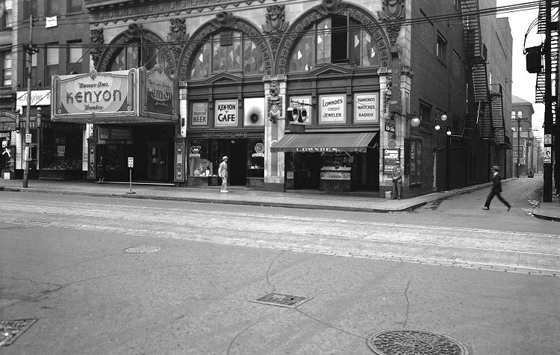
A speakeasy called the M.T.V Club occupied the third floor of this building. The Pittsburgh Post called the club a "rum kennel de luxe" because it had marble-topped tables, expensive rugs, wicker furniture and good whiskey. Entertainment included slot machines, pool games, live or recorded music and, on at least one occasion, a "half-naked Oriental dancer." In the basement of the building was a bowling alley owned by the North Side police inspector. (Archives Service Center/University of Pittsburgh.
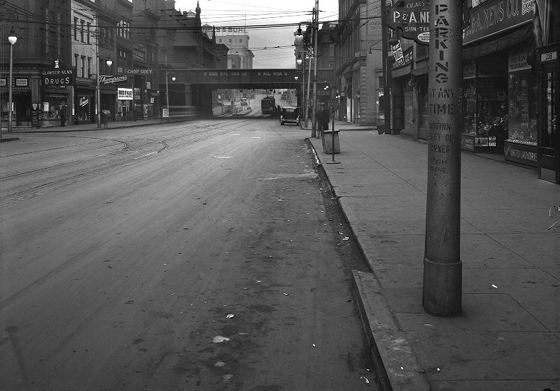
The Pittsburgh Post in 1926 discovered a number of speakeasies within a few blocks from this location. (Archives Service Center/University of Pittsburgh)
1925 map from G.M. Hopkins, "Map of the Cities of Pittsburgh and Allegheny, and the Adjoining Boroughs," courtesy the Historic Pittsburgh website; contemporary map by James Hilston/Post-Gazette.
In East Liberty, a Post reporter entered a speakeasy in the back room of a clothing store at 6299 Frankstown Avenue. The bar was lined with thirsty “rummies,” he wrote, when a police lieutenant named Johnny Jones walked in. “He leaned his tired form against the bar and raised his voice sufficiently to be heard above the rattle of the slot machines. A 'high power beer' was served, which Jones slowly quaffed. Then he cleared his throat, bid everyone a good night and exited. So runs the law in Pittsburgh, Pa., Anno Domini, 1926.”
The city’s worst “plague spot,” however, was the Hill District. “Here vice becomes bestial savagery, debauchery becomes degeneracy, virtue is a joke and decency a rumor,” the Post declared.
So many moonshine joints and whorehouses populated the Hill that a score of reporters couldn’t visit them all in a week’s time, the paper claimed. However, one thirsty reporter did take the time to visit the Paramount Inn on the 1200 block of Wylie Avenue. There, the newsman sat at a table and drank beer while a waitress hiked her skirt above her waist and performed “an obscene dance.”
Trapped in the middle of this lawlessness, the Post noted, were the parents of all races trying to raise families in a neighborhood overrun by vice. The Post tells the story of one man whose 17-year-old daughter was lured into working as a prostitute. The man appealed to an unnamed Hill District leader, who responded, “It’s no use. Your daughter’s gone. Forget about her.”
Others outside the city noticed Pittsburgh’s culture of political and moral depravity. Journalist Walter W. Liggett concluded in a 1930 article that the city was “politically putrid.” His piece, headlined “Pittsburgh —Metropolis of Corruption,” was published in a magazine called Plain Talk and was part of a series on Prohibition and corruption in major American cities.
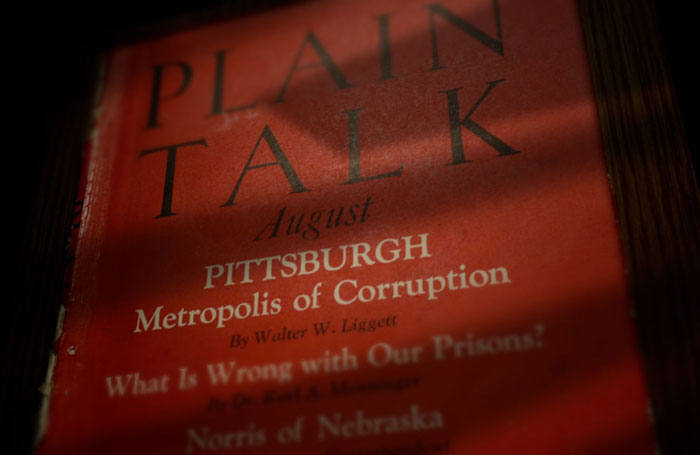
“It is very doubtful there exists such debauched, dishonest or utterly incompetent public officials as those comprising the political machine which mis-manages the affairs and systematically loots the treasuries of Pittsburgh and Allegheny County,” Liggett wrote.
Ward leaders, public officials and police officers accepted “protection money” and in many cases themselves operated speakeasies, brothels or gambling houses. Much of the illegal activity was conducted in the open. Liggett described his visit to a North Side “bawdy house” in which men and boys stood in line at the entrance while police officers sauntered by, casually twirling their nightsticks.
(Liggett’s reporting angered a number of people, some of whom had a history of using violence to make a point. On Dec. 9, 1935, Liggett was gunned down in front of his wife and children outside his apartment in Minneapolis, Minn. The murder remains unsolved.)
At times, police behavior was almost laughable. When up to $5,000 in seized whiskey mysteriously vanished from the Frankstown Avenue police station, the inspector there declared that the barrel bungs, or stoppers, must have leaked. The inspector was thereafter referred to as Bernard “Leaking Bung” Kirley. The Post loved pinning nicknames on police officials it deemed corrupt. Headlines identified the officer in charge of the Hill District station as “Distillery Joe” Elsner. On the North Side, Inspector “Red Light” Charlie Faulkner ruled. Police superintendent Walsh was “The Big Boss” of crime and vice.
It came as no surprise to newsmen when, in 1928, Walsh and a number of his lieutenants, including Faulkner and Elsner, were indicted by a grand jury and charged with conspiracy to violate the Volstead Act. In all, 167 indictments were handed down. Those on the list included two state legislators, the brother of a congressman and a number of ward chairmen.
Not much came of the matter. A handful of people were convicted, but none were police officials or ward chairmen. The only public official convicted was a magistrate.
In this world of corruption and vice, the Volpe brothers came to power and prominence. They controlled, protected and dominated one small community — a clustering of Italian families living in the shadow of George Westinghouse’s massive air brake factory in the small town of Wilmerding, 14 miles from Pittsburgh. The Volpes by turns were shrewd, generous and often ruthless in how they used that control, and were able to leverage their influence into political strength that helped them defeat rivals and enemies. Eventually, they would be drawn to the illegal booze trade in Pittsburgh.
Rise of the House of Volpe
Volpe family members began arriving in the United States in the 1910s, when Italian immigration to the United States was at its peak. First to arrive was the father, Ignazio Volpe, who landed in New York City in February 1901 after a 13-day journey from Naples, Italy. His oldest son John (also known as Giavano) arrived in 1908. Other sons soon joined the family, as did Ignazio’s wife, Rose. She arrived in 1915.
By 1920, the family, which then boasted eight sons, had firmly entrenched itself in Wilmerding. And, according to The Press, the family began selling grapes and groceries. Winemaking was a natural outgrowth. The Volpes displayed an aptitude for a certain type of business. “Violence and cunning shoved competitors out of the way,” reported the Sun-Telegraph.
At the time, Wilmerding was a crowded borough of about 6,400 people. Turtle Creek divided the town. South of the creek was the main business district, the massive castle-like headquarters of the Westinghouse Air Brake Co., and most of the town’s population of Irish, English and German descent.
North of the creek lived immigrants from Italy, Poland, Lithuania and Yugoslavia. This was the Volpe neighborhood. Most men there worked in the Westinghouse factory, known locally as “the air brake.” Federal census records from 1920 listed Ignazio as a “machine hand” in a machine shop, most likely in the Westinghouse factory, just a few blocks from the Volpes’ home. John and James worked in the forge shop. Arthur was a car repairman for a railroad company.
By the time census takers rolled around again, in 1930, John and James Volpe were identifying themselves as grocers — their wholesale business was housed in a three-story brick building at Middle and Bridge streets in Wilmerding. By then, the brothers were also well-known bootleggers.
The Sun-Telegraph described the Volpe organization’s method of distribution: A customer would park his vehicle on the street near the Volpe store in Wilmerding. Then, the customer would enter the store, place an order and wait. A Volpe employee would drive the customer’s vehicle to one of the family’s secret booze storage locations. When the vehicle was returned to its original parking spot, the trunk would be filled with the liquor of the customer’s choice.

In a community of immigrants often resented and intimidated by those in power, the Volpes were viewed my many as protectors and providers. Volpe money and influence filled cupboards with food, piled coal into the cellars of cold homes and, for the unemployed, found jobs in the air brake factory.
And how did the brothers provide protection? One story still circulates in Wilmerding. It involves the Ku Klux Klan. Joe Maurizi, an attorney who represented Louis Volpe during a number of business transactions in the 1960s and whose parents lived for a time in Wilmerding, said the KKK on at least two occasions burned crosses on a hillside overlooking the Italian neighborhood. It was an attempt to terrorize the residents below. After a failed third attempt, the bodies of two Klansmen were discovered on the hillside. Immigrants credited the Volpes, Maurizi said, and viewed it as a sign that the family, and the neighborhood, could not be intimidated.
Verifying the story is difficult, but the simple fact that it continues to be told after more than 80 years hints at the role the Volpe family played in the community.
In return for the food, the jobs, the coal and the protection, the Volpes asked for votes.
And votes they got.
By the mid 1920s, the brothers were well known for their ability to deliver overwhelming Republican majorities in Wilmerding’s 4th Ward on Election Day — a valuable skill during a time when Republicans controlled Pittsburgh and Allegheny County. James Volpe had been elected to Wilmerding’s borough council. A Volpe brother-in-law named Joseph F. Corteal was the town’s police chief.
For years, the Volpe influence allowed the brothers to go about their illegal business largely unmolested by the law. John Volpe was arrested and charged a number of times, but he seemed to live a charmed life. He was tried and acquitted of murder in 1919. In 1926, James Volpe was arrested but escaped conviction in the beating of a prohibition agent who was left unconscious on a road outside the borough. That same year, John and Guy Volpe were suspected in the slaying of Harry Davenport, chief of the Westinghouse Air Brake police. Davenport liked to conduct raids on speakeasies — a dangerous gig. He was hit with two shotgun blasts while standing in front of his Wilmerding house. Nothing ever came of the allegations against John and James.
Federal agents sometimes made raids in the Wilmerding area, but little came of the efforts. In April 1930, agents seized more than 2,300 gallons of liquor ingredients at a “whiskey mash plant” at 136 Middle Avenue — the same address listed in the 1930 U.S. census as Louis Volpe’s home. But authorities found no one on the premises and no arrests were made.
A Volpe could be arrested for beating a newspaper editor (this happened when a reporter tried to get election results from Wilmerding's 4th Ward, controlled by the Volpes) or a police officer; he could face charges for kidnapping, selling liquor, maintaining gambling devices or auto theft and never be convicted.
The reason? Perhaps a clue can be found in the list of speakers at an elaborate farewell celebration staged for the patriarch, Ignazio Volpe, shortly before he returned to his native Italy in April 1929. Toastmaster of the event was the superintendent of county roads, and among those called to the microphone were the assistant district attorney and the assistant superintendent of Pittsburgh Police.
'Uncontrolled sobs'
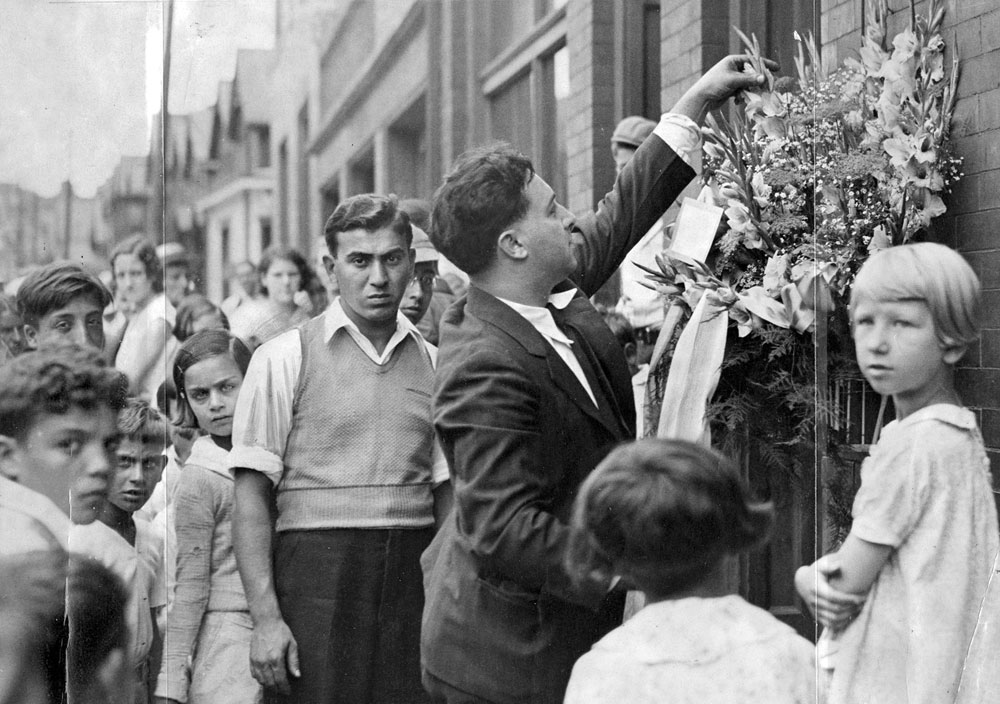
At the Jones Funeral Home in Wilmerding on the Friday evening of the shooting, an elaborate display of palms and ferns was arranged about the open caskets of John, James and Arthur Volpe. Sheets were used to partially cover the bodies and hide bullet wounds.
“There is a startling likeness in the lower facial features of all three,” wrote a Sun-Telegraph reporter. “Three chins thrust out, three sets of lips set in a slight pout, characteristic of the Volpe clan in repose.”
Hundreds, if not thousands, lined up to view the brothers. At one point, the pressure of the crowd became so great that it collapsed an iron gate outside the funeral home. Some mourners wept as they filed past the bodies, some bent down to kiss the cold, dead faces. Others knelt in prayer.
At the Volpe home a few blocks away, three widows grieved. The scene there was detailed by a Pittsburgh Post-Gazette reporter named Anna Jane Phillips, who somehow talked her way into the yellow brick apartment building in which the Volpe clan lived.
Afterward, she wrote a story that reflects the patronizing attitude many white Protestant Pittsburghers felt toward new immigrants who lived in what another newspaper called the “foreign sector.”
“Uncontrolled sobs and moans, broken by the shrill curses of hysterical women, echoed through the Volpe stronghold,” Phillips wrote. “Upstairs, in her tiny bedroom, Amelia, the fat, matronly wife of dapper John Volpe, who for years ruled the other Volpe wives with an iron hand, sat in an armchair, swaying in an agony of grief, four of her six children at her feet. Ten or 12 dark-haired Italian women crowded around her, sobbing, moaning and chattering.”
Two of the surviving brothers -- the story fails to identify which ones -- sat in a living room, unshaven and “ready to oust all outsiders from the place of mourning.” The youngest brother, Raymond, 12, wandered from room to room, “serious but tearless.”
The reporter faced a wall of silence inside the apartment. No one outside would talk to her, either. “Dark-eyed men” were wordless when confronted by a reporter. “Black Italian heads would turn away.”
A bit more respectful was a story in the Pittsburgh Press. Reporter Ruth Ayers wrote that Angela Volpe, wife of James, sat in the “sun parlor of her pleasant apartment house,” twisting a handkerchief in her hands and defending her husband from charges he was a criminal.
“Because he earned money and was generous with it, everyone was too ready to call him a ‘racketeer, a ‘dapper Dan’ and such names,” Angela told Ayers. “But those who knew him, as I did, knew he had a heart of gold. He never turned down a person who wanted help. He gave money, food, clothing to half the people in Wilmerding who were hard hit with this depression.”
At the funeral home, mourners filed past the bodies until late at night. On Saturday, the slain brothers were moved. A half-dozen silent men bore the coffins to the Volpe home, a few blocks away. Following them were hundreds of curious residents.
The caskets were carried to a spacious second-floor room. First to visit the bodies there were the widows. Their “shrieks” made their way through closed doors and windows to those gathered on the street below, newspapers reported. A police detail on duty moved a respectful distance away but remained in the neighborhood to keep the streets clear.

All day Saturday and Sunday, people lined up around the block and waited for hours so they could climb a narrow stairway to see the bodies. A picture published in the Sun-Telegraph shows the line, bending around an A&P grocery store, then extending down the block and out of the camera’s view. Once inside, visitors walked along a narrow path between walls of flowers.
The Sun-Telegraph estimated that up to 7,000 people showed up for the viewing. This proved too much for family members. The funeral, they decided, would be moved from Tuesday to Monday. For Wilmerding residents, it would be an unforgettable event.
Meanwhile, the massive manhunt promised by Pittsburgh police had instead dwindled into a “mild manhunt,” according to the Sun-Telegraph. It had taken 24 hours for the police to interview the remaining Volpe brothers, and authorities were unable to locate any of the half-dozen men who had been inside the coffee shop. All they had was the unhelpful Santo Bazzano.
Police surmised that the killers were most certainly in the lower Hill District, hiding out in what they called a “racket retreat.” The Ford sedan used as a getaway car was found at Forbes Avenue and Seneca Street a few hours after the shootings. Inside were two handguns. Two more were found nearby in a wooden trash barrel. The vehicle was traced to a bogus name and address in Wilkinsburg.
A safe discovered the Rome Coffee Shop was opened. The papers inside were of no use to investigators. What’s more, many of the town’s known racketeers were either out of town or could not be located for questioning.
“Detectives Baffled,” read a small headline in the Sun-Telegraph.
Murder on the rise
In a 1930 article, The Press tried to explain to its readers the rise of Steel City gangsters. In the early years of Prohibition, the newspaper wrote, booze and beer joints operated without the interference of underworld gangsters. All a proprietor needed to do was pay off the authorities who arranged police protection.
This, according to The Press, was the “Golden Age” of the speakeasy operators. By 1926, the era had ended. Pittsburgh’s illicit liquor trade had attracted “Capone-like big shots,” in the words of The Press. They muscled in on the distribution end of the business. Booze retailers suddenly had to deal with “syndicates” who demanded a tribute. Consequently the price of liquor went up from $10 to $15 per case.
Hill District, 1926
Click the black icons below. See Hill District locations. Take a closer look
Take a closer look
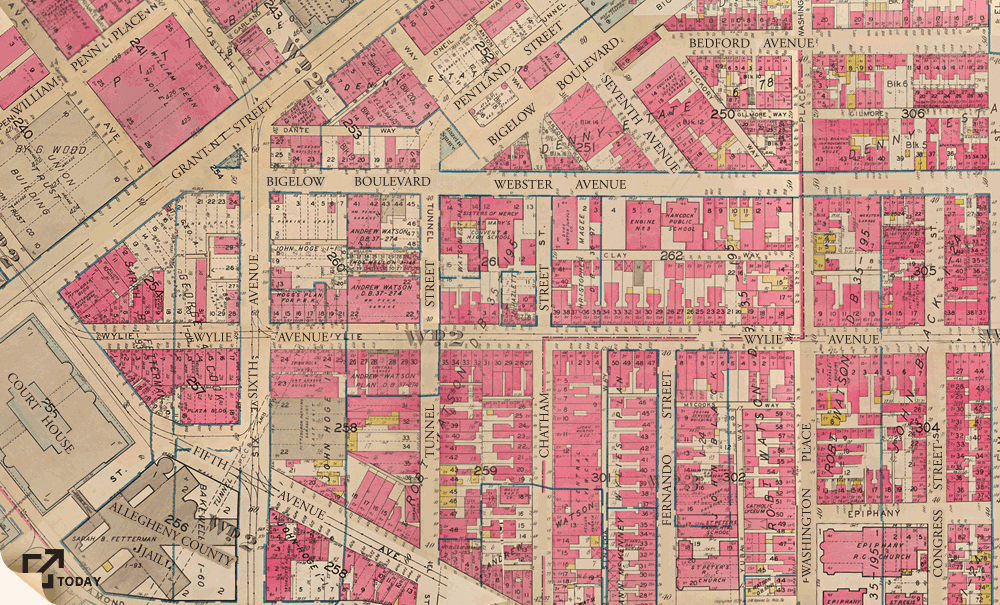

527 Fifth Ave.
John Volpe received a shave and a shoeshine here less than an hour before he was killed. In the shop with him were racketeers Frank Modarelli and Joe Tito.
704 Wylie Ave.
One of the city's most shocking and brazen murders took place at this small shop during lunch hour on Friday, July 29, 1932.
717 Wylie Ave.
Racketeer Jack Palmere was shot to death while chatting with a friend at about 7:30 p.m. on Oct. 7, 1931.
901 Wylie Ave.
A bomb blasted Joe Pangallo from his automobile on Sept. 19, 1927. The explosion hurled Pangallo into the air and wrecked his car. He survived.
Luigi Lamendola, nicknamed "Big Gorilla," was killed by two gunmen at his restaurant and headquarters on May 19, 1927.
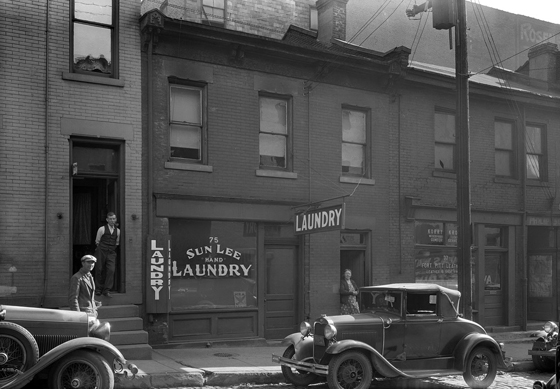
A laundry and a leather shop occupied this block in the early 1930s. (Archives Service Center/University of Pittsburgh)

Traffic jams were a problem at this intersection as early as 1925.

The photographer taking this picture was standing on the 700 block of Wylie Avenue, where the Volpe and Palmer murders took place. (Archives Service Center/University of Pittsburgh)
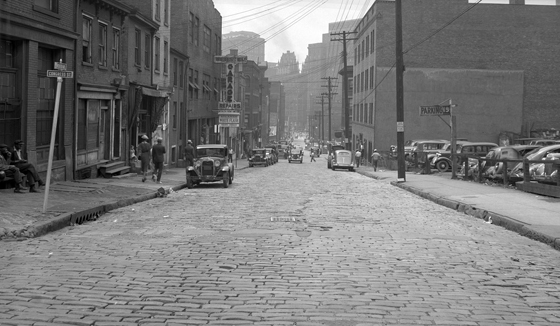
The Webster Avenue Garage, where John Volpe's automobile was stored after the shootings at the Rome Coffee Shop, can be seen on the left. (Archives Service Center/University of Pittsburgh)
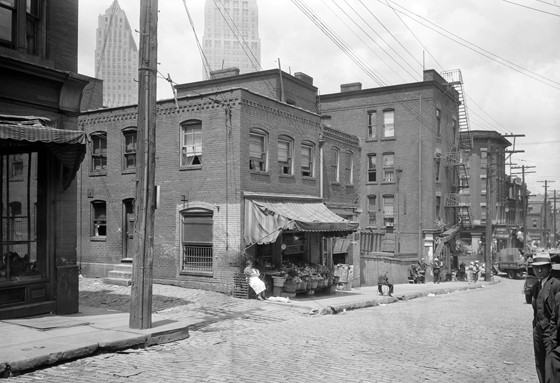
The Koppers Building and Gulf Tower loomed over this bustling neighborhood. (Archives Service Center/University of Pittsburgh)
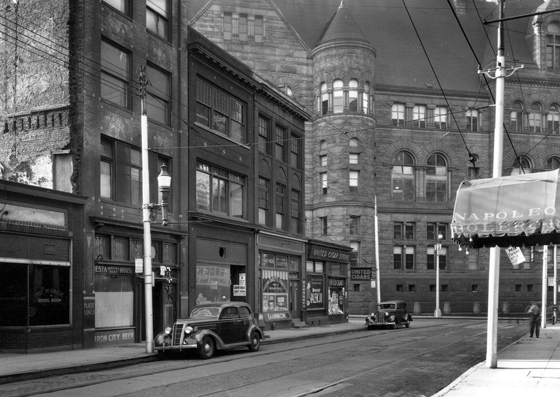
Tobacco stores and restaurants dominated this block in the 1930s. (Archives Service Center/University of Pittsburgh)
1929 map from G.M. Hopkins, "Map of the Cities of Pittsburgh and Allegheny, and the Adjoining Boroughs," courtesy the Historic Pittsburgh website; contemporary map by James Hilston/Post-Gazette.
Folks started to make money. Real money. And as the profits rose, so did the risks. Being a booze baron in Pittsburgh was a dangerous profession.
One of the first killings to make the news was that of Luigi Lamendola, nicknamed “Big Gorilla” because of his size and shape (he was 5-foot-8 and weighed 224 pounds). The moniker irked Lamendola, so few used it in his presence.
In 1925, Lamendola established a speakeasy on Chatham Street in the Hill District and served notice that all other speakeasy owners would have to buy their booze from him. Those who refused were beaten or killed, their whiskey runners hijacked. Chicago-style violence had arrived in Pittsburgh.
Lamendola’s reign was brief. On a warm May evening in 1927, he was gunned down while standing in the doorway of his speakeasy. During the autopsy of Lamendola’s body, eight lead slugs were found in the cranial cavity.
A hand-written note on the coroner’s report read, “ ... I have known the deceased for several years and I am positive that he has no relatives in this country. I know nothing of the circumstances leading up to my friend’s death.”
 The statement was signed, “S.J Monastero.”
The statement was signed, “S.J Monastero.”
Luigi Lamendola had closed his Chatham Street restaurant for the night
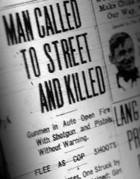 when two men knocked on the storefront window to get his attention. The men signaled for Lamendola to come outside. When he stepped to the restaurant’s doorway, gunmen waiting inside a vehicle parked in front of the restaurant opened fire. Lamendola fell, mortally wounded. Gunmen continued to fire, wrecking the restaurant.
when two men knocked on the storefront window to get his attention. The men signaled for Lamendola to come outside. When he stepped to the restaurant’s doorway, gunmen waiting inside a vehicle parked in front of the restaurant opened fire. Lamendola fell, mortally wounded. Gunmen continued to fire, wrecking the restaurant.A patrolman ran to the scene, drew his revolver and fired several times at the fleeing vehicle. Gunmen continued to fire. One bullet crashed through the window of the New Italy restaurant at Webster Avenue and Chatham Street, narrowly missing a violinist performing inside.
Detectives described Lamendola as a short and powerfully built man who used his fists to beat those who crossed him. He’d agreed to pay $50 in monthly rent for the Chatham Street storefront that housed his restaurant, but the owner feared calling on Lamendola, so the rent hadn’t been paid.
Police said Lamendola had been sending $1,000 each month to relatives in Italy. Four $1,000 bills were found in the dead man’s pockets.
Lamendola had a number of enemies. Police received several anonymous tips, but no two implicated the same men as the killers. Lamendola’s body was sent for burial to his birthplace of Genoa, Italy.
Steve (or Stefano) and Sam Monastero made the trip to St. John’s General Hospital
 Steve Monastero on McClure Street in their usual manner -- traveling in a bullet-proofed car, followed by a posse of armed men in a second vehicle. The brothers were visiting a fellow gangster suffering from appendicitis.
Steve Monastero on McClure Street in their usual manner -- traveling in a bullet-proofed car, followed by a posse of armed men in a second vehicle. The brothers were visiting a fellow gangster suffering from appendicitis.The brothers pulled their vehicle to the curb, exited and walked to the hospital entrance. Along the way, they passed a parked sedan with drawn shades. Suddenly, shotgun barrels emerged from the windows. In the barrage that followed, Steve fell mortally wounded. Sam fled into the hospital. A gunman exited the sedan and fired several rounds from a pistol into Steve’s head.
A short time after the shooting, police caught up with Sam in a nearby neighborhood. He was arrested and taken to jail, where he became hysterical and threatened to kill himself. Authorities handcuffed him to a cell bar.
Sam was released and carried on the family business until March 18, 1930, when his armored automobile was found in the mud of Jack’s Run near West View. The vehicle’s engine was running, its wheels spinning. Inside was Sam’s body. He’d been strangled with his own $15 hand-painted necktie.
A woman identified as Mrs. H.E. Damp peered into the early morning light and saw a
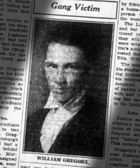 wooden barrel resting against a tree near her home in Penn Township. She suggested to her son they could use the barrel for kindling. The son never got around to fetching the barrel -- a good thing, since it was later discovered to contain a headless body, its legs and feet sticking out of the barrel’s top.
The body belonged to booze runner William “Stuttering Bill” Gregory, although authorities wouldn’t figure that out until Gregory’s head was found a mile and a half away. The head was wrapped in a copy of The Pittsburgh Press, dated Monday, March 31, 1930, and placed in a burlap bag marked “Three Star Brand Potatoes.”
wooden barrel resting against a tree near her home in Penn Township. She suggested to her son they could use the barrel for kindling. The son never got around to fetching the barrel -- a good thing, since it was later discovered to contain a headless body, its legs and feet sticking out of the barrel’s top.
The body belonged to booze runner William “Stuttering Bill” Gregory, although authorities wouldn’t figure that out until Gregory’s head was found a mile and a half away. The head was wrapped in a copy of The Pittsburgh Press, dated Monday, March 31, 1930, and placed in a burlap bag marked “Three Star Brand Potatoes.”Gregory’s body was covered in bruises, his breastbone broken. His skull was crushed before he was decapitated. His sin? He’d sold a load of booze he’d been hired to deliver, then claimed the booze and the truck had been hijacked.
Police checked a “wildcat brewery” on Lorigan Street in Bloomfield, where Gregory was known to have met bootlegger Philip DeFazia. Walls and floors in the one-story building had been sprinkled with lime. Still, detectives saw spots they believed were blood stains. DeFazia was arrested but later acquitted on charges stemming from the murder.
Shortly after 9 a.m., a maroon sedan pulled to the curb and stopped on the 400 block of
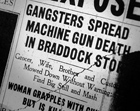 Sixth Street in Braddock. Two men exited the vehicle and casually walked past 10-year-old Frank Coffee and into the Lobianco Brothers grocery store. Moments later, Coffee heard the pop-pop-pop of gunfire.
Sixth Street in Braddock. Two men exited the vehicle and casually walked past 10-year-old Frank Coffee and into the Lobianco Brothers grocery store. Moments later, Coffee heard the pop-pop-pop of gunfire. Coffee watched as the two men exited the store and walked to their car. “They climbed in and sat there a few seconds as if nothing had happened,” he told The Pittsburgh Press. Then the men drove away. Neighbors rushed to the store and made a grisly discovery. Four people lay bleeding on the floor. They were Joseph Lobianco, his wife Mary, a brother Carmen and a customer named Louis Tomano. Mary Lobianco remained alive and was rushed to Braddock hospital, where doctors tried unsuccessfully to save her life and that of her unborn baby.
In a back room of the grocery, police found the Lobianco’s 17-month old baby, unscathed. A 12-year-old delivery boy named Clarence Moore hid behind a counter when the shooting started. “There were so many shots and people falling dead, I ducked out and ran home,” he said afterward.
When police visited Carmen Lobianco’s home, they found a 500-gallon still and 10,000 gallons of whiskey mash.
Sometime around noon, golfers teeing up at the Pittsburgh Country Club in Squirrel Hill
 heard the screams of a woman seeking help. They looked up to see a hysterical Mary Siragusa, who lived a short distance away on Beechwood Boulevard.
heard the screams of a woman seeking help. They looked up to see a hysterical Mary Siragusa, who lived a short distance away on Beechwood Boulevard.Mary had just returned home from Sunday Mass at St. Philomena’s Church on Forward Avenue to find her husband sprawled at the bottom of the basement steps. His face was covered with shaving cream lather. Gunmen had interrupted his morning routine. Siragusa died with five bullet wounds to his head and body.
Lying on Siragusa’s lifeless form were two holy pictures that had been tacked to a post Siragusa grabbed as he fell. And from a cage nearby, a parrot named Polly shrieked incessantly, “Poor Joe, poor Joe.” The bird would squawk for at least two hours.
Siragusa’s daughter Catherine, 7, had slept peacefully in her bedroom upstairs while gunmen fired the shots that killed her father.
Around 7:30 p.m., Jack Palmer (or Palmere) strolled to the front of a small grocery store at 717 Wylie
 Ave. and sat down next to his buddy Joe Colelli. The two chatted for about 15 minutes when suddenly a gunman wearing a blue suit and brown hat approached the two, pointed a pistol at Palmer’s head and fired from a distance of 15 feet. “The bullets whizzed past my ear,” Colelli later recalled. “I thought I was killed. I am still trembling.”
Ave. and sat down next to his buddy Joe Colelli. The two chatted for about 15 minutes when suddenly a gunman wearing a blue suit and brown hat approached the two, pointed a pistol at Palmer’s head and fired from a distance of 15 feet. “The bullets whizzed past my ear,” Colelli later recalled. “I thought I was killed. I am still trembling.”Newspaper stories about Palmer’s death said he was running a sugar and yeast racket yielding an estimated $1 million per year. He died wearing a $2,000 diamond ring, his pockets stuffed with several thousands of dollars in large bills.
Around noon the next day, a farmer searching for his cows near Turtle Creek noticed flames in weeds near a creek bank. The farmer investigated and discovered the body of Palmer’s partner, Saverio “Toto” Amarosa (newspapers sometimes used the name Argenti). Amarosa, described as short and stocky, was strangled with a clothesline and stabbed with a knife. Then his body was stuffed into a burlap bag, doused with gasoline and set on fire.
Most likely this was one of the Monastero brothers -- Steve (also known as Stefano) or Sam, both bootleggers. Their use of the phrase “my friend” is interesting in that newspapers at the time implicated the Monasteros in Lamendola’s murder.
The Monasteros headed the largest organized gang on the North Side. They were ruthless with rivals. One was Lamendola. Another was Joe Pangallo, who controlled the Hill District rackets. Pangallo was blasted from his car by a bomb on Sept. 19, 1927. He survived.
Pangallo was nearly impossible to kill. He was shot at least three times, never fatally. Pneumonia ended him in 1930, before he could become boss.
Another Monastero rival was Morris Curran. When his moonshine business inched into the Monasteros’ turf, Curran’s three-story headquarters was leveled by a bomb.
The Monasteros’ rule began to fall apart in 1929. On Aug. 6 of that year, the brothers were ambushed in front of St. John’s General Hospital on the North Side. A shotgun blast killed Steve. Sam escaped to carry on the family business, at least for a short while. On March 18, 1930, his body was pulled from the back seat of his Buick Club Coupe, which had run off Jack’s Run Road near Bellevue. Sam’s necktie was twisted tightly around his neck. A towel had been stuffed in his mouth.
Next came one of the era’s most gruesome murders. A hard-luck booze runner named William “Stuttering Bill” Gregory was tortured, killed and beheaded after stealing a load of bootleg alcohol. His body was found, stuffed in a barrel in Penn Township, on April 1, 1930.
Violence reached a shocking level on Saturday morning, Oct. 4, 1930. Shortly after 9 o’clock, gunmen walked into the Lobianco Brothers grocery store in Braddock and shot to death four people, including owners Carmen and Joseph Lobianco and Joseph’s pregnant wife Mary. The couple’s unborn child could not be saved.
Police discovered the shop’s stock consisted almost entirely of sugar and yeast. “This is plainly a racket murder,” claimed Allegheny County Coroner W. J. McGregor.
Several days later, police made an interesting discovery. Among Joseph Lobianco’s effects were checks endorsed by James Volpe. This bit of news certainly raised some eyebrows, and police tracked down James for questioning. But he claimed the checks were in payment of loans to Lobianco, and so police let the matter go.
By 1931, a new racket boss had emerged. His name was Giuseppe, or Joe, Siragusa. Newspapers called him the “Yeast Baron,” because he supplied the sugar and yeast necessary to make booze. He and his wife, Mary, lived in a spacious $35,000 home on Beechwood Boulevard in Squirrel Hill.
On Sept. 13, 1931, Mary returned home from Sunday church services to discover her husband’s body sprawled at the bottom of the basement steps. Siragusa died from bullet wounds to his face, head, chest and arm.
Next to die was Jack Palmer, the racketeer shot in the head in front of a Wylie Avenue grocery store, across the street from the Rome Coffee Shop. Less than a day later, a Palmer partner named Saverio “Toto” Amarosa was found dead near Turtle Creek. He had been shot and strangled and his body set on fire.
The Press by then was keeping a tally of Allegheny County’s unsolved gangster murders. Palmer was victim 91; Amarosa was 92.
Through it all, one low-key racketeer was able to steer clear of trouble, bullets and knives, even as his wealth and influence grew. The time had come for a quiet, unassuming man named John Bazzano to become Pittsburgh’s underworld leader.
'Santa Claus taken away'
Wilmerding’s Italian community turned out in force to see the three slain Volpe brothers carried away to their graves.
People began clustering on the street outside the Volpe home before dawn on Monday, Aug. 1, 1932. By 9 a.m., the crowd numbered more than 5,000 and both the sun and temperature were rising. Police began waging a battle to create a space for arriving funeral cars. Children packed the fire escape of the Gottswall public school and got an excellent view of the scene.
Battling their way through the crowd were “small but somewhat sinister groups of henchmen” who roughed up news photographers and surrounded those who appeared to be outside the feudal kingdom of Volpe. Hours passed. The crowd got restless. Fights occasionally broke out. Police on motorcycles forced their way through the sweaty mass. Detectives manned the street corners, keeping an eye out, nervous about another “hit.”
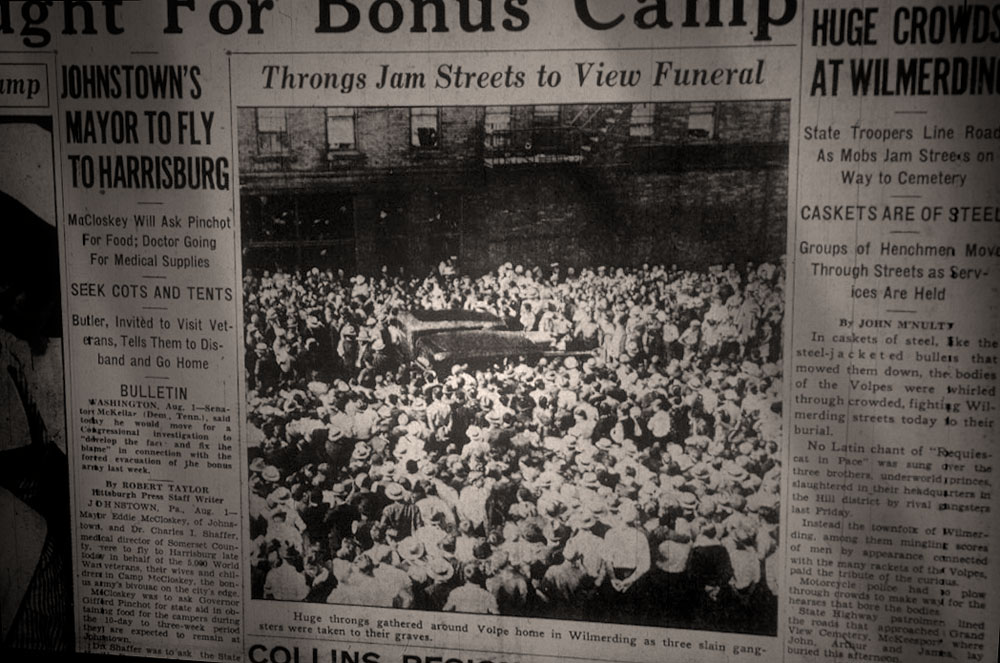
Business in Wilmerding came to a standstill. “Everyone, merchant or mechanic, storekeeper or poolroom idler, or man of sinister occupation, is at the funeral,” The Press reported.
Wedged in as it was, the crowd parted for one visitor — Louis Volpe, recognized by everyone in town. Louis had been permitted to leave jail for a few hours so he could say goodbye to his dead brothers. He was accompanied by a deputy United States marshal named David Goldman.
The two men made their way to the Volpe building's second floor, where the widows and children of the slain men gathered around the caskets and wept. It was a scene that saddened even a U.S. marshall. “Louis looked down at the boys. Then he burst out crying,” Goldman told the Sun-Telegraph. “It was mighty sad. He just broke down.”
Later, a lone priest fought his way through the throng and into the Volpe apartment. He prayed for 15 minutes, then departed. For John, James and Arthur, there would be no official funeral, no eulogies within the walls of a church. St. Aloysius Catholic Church in Wilmerding had barred its doors to the family
Only “practical” Catholics who had regularly received sacraments of the church were entitled to Catholic rites at St. Aloysius, explained Father M.A. McGarey. The Volpes, he said, did not qualify.
Finally, the metal casket containing John Volpe’s body, borne on the shoulders of pallbearers in shirt sleeves, emerged from the narrow front door of the family’s home. Now the crowd became nearly uncontrollable, surging forward and threatening to overun the pallbearers. The chaos sent John Volpe’s pet bulldog into a fit of barking. Police called for funeral cars to move down the street two-abreast to create some space.
Once loaded, three hearses rumbled through town, leading a procession of approximately 250 vehicles.
The scene at Grandview Cemetery in East McKeesport was nearly as chaotic as it had been in Wilmerding. Vehicles on Lincoln Highway, or Route 30, were parked “as closely as the Volpe gang had cased its bottles of bootleg booze against each other,” the Sun-Telegraph reported.
The three widows and what remained of the Volpe clan stayed in their cars with the blinds drawn. No children of the slain men were allowed to see their fathers lowered into the earth. Pallbearers knelt to pray. A few people wept.
Perceptions of the day’s events varied. To the Post-Gazette, it was a “pageant marked by the same curious mixture of gaudy splendor and upstart squalor that colored every hour of the Volpes' lives.”
For those who struggled through life in Wilmerding, however, the day’s events brought a true sense of sadness.
“It is not only the youngsters who will miss them,” The Press quoted one source. “For them, it is like having their Santa Claus taken away. The grown folks will miss them, too, because no matter what anybody says, they helped a lot of people.”
Trouble in the Volpe stronghold
Shortly before primary elections in September 1931, John Volpe put on an ambitious and audacious display of political power. He called a meeting of nearly every candidate supported by his organization. The gathering in mid August was the largest of its kind in Wilmerding — 200 people were turned away for lack of seating at Philaretic Hall, newspapers reported.

| 1920 | Prohibition begins |
| 1922 | First Liberty Tunnel is completed |
| 1923 | Charleston dance becomes popular |
| 1925 | Pirates win World Series |
| 1926 | Charles Kline becomes 46th mayor of Pittsburgh |
| 1927 | Charles Lindberg flies solo across the Atlantic Ocean |
| 1929 | Stock market crashes |
| 1931 | Gangster Al Capone given 11-year prison sentence for tax evasion |
| 1933 | Prohibition repealed |
John Volpe chaired the meeting, calling up speakers who included a county commissioner, four judges, the district attorney, the assistant district attorney, the clerk of courts, the county controller and several others. After the gathering, a number of candidates made their way to the Volpe residence for a party.
By all accounts, the event was a smashing success. And when the ballots were counted on election day, the Volpe organization received an overwhelming majority in their home ward, the 4th. It was good news for the Volpe organization — too good, it turned out. The results seemed a bit fishy, partly because they weren’t available until 48 hours after the polls closed. Officials impounded the 4th Ward ballot box.
Several candidates running as independents saw the results and cried foul. They had been trying for years to oust the Volpes from power. Wilmerding, they charged, was overrun by lawlessness thanks to John and James, who used beatings and intimidation to control the borough. The family was running amok, reformers claimed. The brothers were so brazen that they shot up the borough’s police station in an attempt to rescue a prisoner, independents said. Church groups began canvassing door to door for reform candidates. Women became active.
The independents charged Volpe forces with stuffing 300 ballots into the 4th Ward ballot box before the polls opened on Election Day. What’s more, they said, a number of voters didn’t even exist. As proof, the independents mailed registered letters to all voters in the district — 125 were returned because mail carriers couldn’t find the people addressed. Miraculously, four deceased people managed to vote, the independents said.
That was bunk, declared John Volpe. He said he had known a number of those so-called “phantom voters” for years. “Some of the people become frightened when they see the mail,” John Volpe explained at a hearing. “They think that someone is going to kill them. They do not like to receive mail.”
Two federal judges disagreed. They purged more than 150 votes from the 4th Ward lists. The situation in Wilmerding was heating up.
Trouble was anticipated in a subsequent election several weeks later, and 25 deputies were brought in to guard the Wilmerding polls. The results were shocking. In the 4th Ward, only 466 votes were cast, all by living voters, and the Volpes were swept from power for the first time in 10 years.
It was a stunning loss for the Volpe clan, and there was some indication the brothers didn’t take it well. Newspaper reports state Louis was charged with “malicious mischief” for throwing bricks through the windows of homes and businesses of the independents who had pried loose the family’s grip on Wilmerding.

Guy Volpe hides behind his lawyer to avoid photographers. (Pittsburgh Press photo)
Misfortune struck the family again in December when Louis was nabbed in a sort of sting operation. To make a buy, federal authorities rigged a truck with a secret compartment in which two agents could hide. Those agents watched as Louis sold a 5-gallon jug of whiskey for $16. Another agent said he bought a pint of whiskey from Louis. The cost: 50 cents.
Wallowing in self-pity, however, was not the Volpe style. The brothers followed their dramatic 1931 setbacks with an equally dramatic, and ambitious, move: They came to Pittsburgh with the idea of “muscling in” on territory jealously guarded by other racketeers. And why not? Some office doors on Grant Street remained open to them. And the Volpes were quite familiar with the strong-arm tactics needed to compete in the violent booze and gambling business.
Within a few months, the Volpe plan seemed to be working. The brothers had taken over rackets in the city’s East End and were moving into Downtown, Oakland, Bloomfield, East Liberty, the Strip District and the Hill District.
By the spring of 1932, the Volpes had decided it was time to flex some muscle. John Volpe called a meeting of city racketeers at a Downtown hotel — newspapers fail to specify which one or the date of the meeting. Invitations were sent to approximately 100 Pittsburgh liquor dealers. About half showed up. Others sensed trouble, and they were right in doing so. Newspapers reported that John Volpe demanded that the gathered bootleggers adopt a price schedule he had proposed. Rates were going up, he said.
When North Side racketeers objected, John Volpe told them they should go along “or else.”
“Go to hell,” replied the North Siders.
At least one racketeer, however, had decided to work with the Volpes. This was John Bazzano, the unassuming man who, after the deaths of Jack Palmer and Joe Siragusa, had risen to the top of Pittsburgh’s racket scene. Newspapers, in fact, identified Bazzano as “executive head” of the Volpe organization.
The Volpe-Bazzano alliance was strange and unlikely. The Volpes — John, especially — were flashy, brash and violent. They threw lavish parties, hung out in nightclubs and flashed wads of cash. They lived among other Italian immigrants in a crowded, often rowdy neighborhood in the shadow of a massive industrial facility. Bazzano, by contrast, was a low-key family man who lived with his wife and five children in a beautiful stone house on Washington Boulevard in an exclusive section of the suburb Mt. Lebanon. The house still stands, looking much as it did in the early 1930s.
Bazzano had immigrated from Italy to the United States in 1909 and as a young man lived in West Virginia and then Johnstown, Pa., working as laborer and a clerk.
He became a U.S. citizen in 1916, enlisted in the military, served during World War I, and afterward married and moved to New Kensington. By 1930, he and his wife, Rose, had moved to the Pittsburgh area. The U.S. census that year lists him as a retail merchant and confectioner. And he was owner of the Rome Coffee Shop.
By the spring of 1932, that shop was serving as a meeting place for the Volpe brothers, who had become increasingly ambitious. They had invaded the North Siders’ territory by purchasing an interest in a Babcock Boulevard roadhouse. It was a defiant move, and the brothers had to know it would anger and alarm some very dangerous men.

The only picture of John Bazzano in the Post-Gazette photo archives was shot a few days after the Volpe murders. He was being questioned by police and appears as a stocky man, his black hair combed back (autopsy notes would later indicate the hair was streaked with gray). He’s wearing a light-colored striped suit, vest and tie. Bazzano is staring blankly into space while Pittsburgh detectives question him. He looks like the quiet, unassuming man described in newspaper stories.
Sitting beside Bazzano is his attorney, Frank J. Zappala, who also happened to be Bazzano’s brother-in-law. Zappala holds a cigar in his left hand.
(Zappala’s name turns up in news stories indicating he represented Guy and Louis Volpe as they faced charges of violating prohibition laws in 1929.)
Police had requested the interview, and Bazzano agreed to meet authorities at detective headquarters. The interview lasted 30 minutes. Bazzano told investigators he knew nothing about the murders — at the time of the shootings, Bazzano said, he was tending to business in Midland, Beaver County. Like his brother Santo, John Bazzano insisted that the Volpes were his friends. Police saw no reason to detain him.
A few days later, authorities wanted to speak with John Bazzano again. Family members, however, said Bazzano was gone — he had departed on Aug. 4. His wife, Rose, didn’t know where he was going, or why. It wasn’t John’s habit to talk about business with his wife.
Authorities struggled to learn more about Bazzano. Outwardly, he seemed like a good family man who could afford to lavish luxuries on his wife and five children. He lived in a tony suburb far from the dirty racket worlds in Pittsburgh. Folks in New Kensington, where Bazzano had lived before moving to Mt. Lebanon, remembered him as a good citizen and shrewd businessman who imported olive oil and Italian foods. He certainly didn’t seem like a man shoulder-deep in bootlegging and gambling. He kept that part of himself hidden, even from his family.
Police began keeping an eye on the Bazzano house. Authorities suspected the place was a hideout for “Big Mike” Spinelli, the former Volpe bodyguard seen by witnesses on Wylie Avenue the day of the Volpe murders. But where was Bazzano?
On Thursday, Aug. 11, police announced they had found the mysterious gangster.
Grisly end
Less than a week after the Volpe killings, Bazzano and two other men had been summoned to New York City by the recently formed La Cosa Nostra Commission, a group of underworld big shots whose duty it was to arbitrate gangland disputes and, when needed, punish those who had gone astray.
Bazzano and his traveling companions checked into the Hotel Pennsylvania in midtown Manhattan. One of the men accompanying Bazzano was Spinelli. The other was most likely Joe Tito, the racketeer who was with John Volpe in Manna’s barber shop less than an hour before the hit.
Gangsters knew all along who was behind the Volpe hit: Bazzano.
Spinelli and Tito didn’t stay long in the Big Apple. Bazzano, however, was called to a gathering on Aug. 6. So he dressed himself in a gray-brown jacket and vest, white silk socks, tan oxford shoes, and brown pants with a pencil stripe, then traveled to an abandoned building in the Red Hook section of Brooklyn.
It’s unclear exactly what occurred at the meeting. A report in The Press in 1935 states that Bazzano was the guest of honor at a banquet, where fellow gangsters toasted him for the Volpe slayings. After the celebration, a few of those in attendance offered Bazzano a ride back to his hotel. The men, according to the report, were loyal to the Volpes, a fact unknown to the racketeer from Mt. Lebanon. Other reports said Bazzano was brought before the commission and asked to defend his actions, which were unsanctioned by the big bosses. Bazzano, these reports state, was less than convincing.
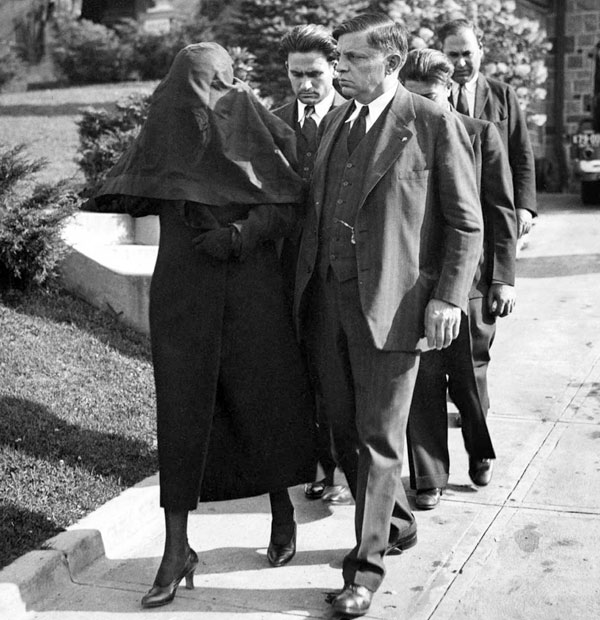
Rose Bazzano is escorted from her during her husband's funeral. (Pittsburgh Press photo)
Either way, the evening proved unhealthy for Bazzano.
In the predawn darkness of Aug. 8, a 19-year-old man walking to his Brooklyn home discovered a large burlap bag near a refuse pile called Tin Can Mountain. He investigated and made a grisly discovery: Inside the bag was the body of a middle-aged white male, about 5 feet, 9 inches tall and weighing 190 pounds. The arms and legs had been trussed up by rope. A bloodstained white handkerchief was stuffed in the mouth. Rope burns marred the neck. An autopsy would reveal the man had been stabbed up to 20 times with an ice pick.
New York City lawyer Andrew Zappala, brother of Frank, identified the body on Aug. 11 as that of his brother-in-law, John Bazzano.
Rose Bazzano took the news hard. She sat in the darkened drawing room of her luxurious Mt. Lebanon home and pleaded, “John, come home.”
She screamed her husband’s name and “wept so fiercely that even a physician could not prescribe a remedy to quiet her,” wrote Ruth Ayers, the Press reporter who a few weeks earlier had written about the Volpe widows.
In a nearby room, her husband’s punctured body rested in a $5,000 casket.
The funeral at the Bazzano home on Saturday, Aug. 13, was in stark contrast to the chaotic events at the Volpe funeral a few weeks earlier. Bazzano’s body was blessed in the home by a priest. Then dark-suited pallbearers carried the casket out the front door and down a walkway to a waiting hearse. A short distance behind walked Rose Bazzano, her face covered by a black veil. She was followed by her brother-in-law, Santo. A procession of 75 cars, seven loaded with flowers, accompanied the hearse to a cemetery in Arnold.
A few days later, police in New York city arrested 14 mobsters they suspected of taking part in Bazzano’s death, but couldn’t find enough evidence to charge them. Instead, they were charged with loitering. The Bazzano murder would remain unsolved.
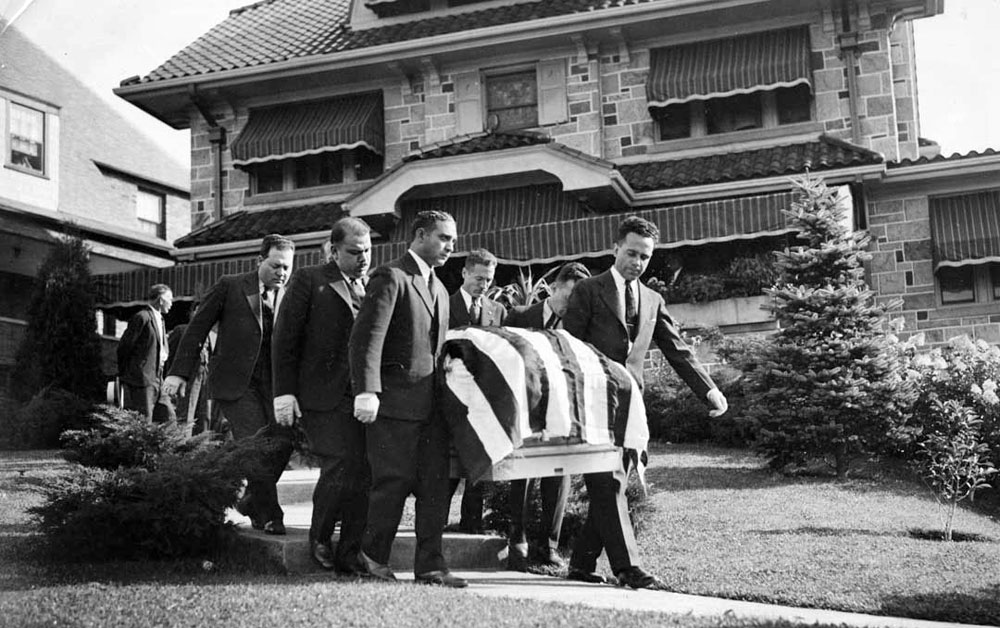
The lowering of John Bazzano’s body into the earth at a Westmoreland County cemetery marked the end of an era. Gangland murders would subside in the coming months and years. The atmosphere that fostered the violence and allowed bootlegging gangs and speakeasies to thrive was dissipating. In less than a year, 50,000 people would gather around Pittsburgh’s three major breweries and wait for the moment they could purchase cases of beer containing 3.2 percent alcohol, which had just been legalized. The date: April 7, 1933.
Survivors pay a price
Eight months later, prohibition was officially repealed. Racketeers returned to traditional sources of income: gambling, extortion and loan-sharking. The mob remained a presence in Pittsburgh, headed by guys like Vincenzo Capizzi and Frank Amato Sr., but the dark days of brazen violence had largely come to an end.
Gangsters of the 1920s and 30s — the Volpe brothers, John Bazzano, Stephano and Sam Monastero, Luigi Lamendola and the others — would, over time, slowly fade from the city’s memory.
On Wylie Avenue, the Rome Coffee Shop and all its furnishings, including a huge coffee urn imported from Italy, were seized in lieu of $585 in unpaid rent. Later, the building was used as a junk shop and then as numbers joint. A fortune-telling studio occupied the first floor in the building’s final months. Redevelopment came to the lower Hill in 1956, and the sagging structure that was once a gangster headquarters was reduced to rubble.
John Volpe’s luxurious Cadillac continued to roam the streets, at least for a while, after its owner’s death. Police saw the flashy vehicle outside the Penn-Shady Hotel in East Liberty in May 1933. Inside the hotel, they found Louis Volpe and a number of other racketeers suspected of running an alcohol ring.
Louis Volpe attracted a lot of police suspicion after the deaths of his brothers. He had faced charges for allegedly assaulting a man who refused to allow his storeroom to be used as a liquor warehouse, and for threatening another man for the same reason. He and his brother Joseph remained in jail on the latter charges because they couldn’t come up with bail money, a situation unimaginable a few years earlier.
By the 1960s, Louis was involved in more legitimate businesses like supplying cigarettes for vending machines. And he had acquired an interest in the Rainbow Garden Amusement Park in White Oak.
His attorney during those years, Joseph Maurizi, remembers Louis in his later years as a man who enjoyed sitting on a park bench in Wilmerding, chatting and waving at passing friends and acquaintances. Louis died of kidney failure on June 5, 1987, at Shadyside Hospital.
Guy Volpe was the first of the brothers to die a nonviolent death. Guy was described in newspapers as more laid back than the rest of the clan. People in Wilmerding knew him as the banana seller, because he handled the legitimate side of the family business. His brothers’ deaths took a toll on him. He died of a “paralytic stroke” on April 8, 1934. Alcohol was most likely the cause, death records stated.
And the man who pulled the trigger and took the life of John Volpe? “Big Mike” Spinelli remained an elusive figure, for a while at least. Three weeks after the Volpe shootings, Spinelli was spotted at a restaurant next door to Manna’s barber shop, where John Volpe received his final shave and shoeshine. Later, he was traced to Turtle Creek.
Newspaper reports indicated Spinelli eventually fled to Canada, then traveled by ship to Italy. There, in the town of Agropoli, he was reunited with his mother, wife and two children. On Nov. 23, 1932, he was arrested by Italian authorities. Pennsylvania officials asked for Spinelli’s extradition, but the Italian minister of justice said no. “Big Mike” would be tried in Italy. In December 1935, he was convicted, and sentenced to 30 years.
Ignazio Volpe, father of the family that once dominated the Pittsburgh rackets, never returned to the United States after departing in 1929. On Aug. 18, 1936, the old man died on the small farm where he was born, a short distance from Agropoli. And there Ignazio was buried, more than 4,000 miles from the simple graves of the sons who had followed him three decades earlier in search of opportunities in a new country. 
Credits
| Writing | Steve Mellon |
| Design | Daniel Marsula |
| Interactivity | Laura Malt Schneiderman |
| Art | Daniel Marsula |
| Editing | Allan Walton |
| Copyediting | Lillian Thomas Bill Lowenberger |
| Research | Steve Mellon Laura Malt Schneiderman |
| Maps | James Hilston |
| Videography | Steve Mellon |
| Video narration | Steve Mellon |
| Image editing | Steve Mellon Laura Malt Schneiderman |
Sources
Much of the information for this report was gleaned from the Post-Gazette newspaper and photographic archive and from the pages of the Pittsburgh Post, the Post-Gazette, The Sun-Telegraph and The Pittsburgh Press. Back issues of these newspapers were accessed on microfilm at the Post-Gazette and the Carnegie Library of Pittsburgh, Oakland.
Other sources include:
Allegheny County, Pa., Coroner Office Records, 1884-1976, AIS.1982.07, Archives Service Center, University of Pittsburgh.
City of New York, Municipal Archives.
United States Federal Census, 1910, 1920, 1930, accessed through Ancestry.com.
New York, Passenger lists, 1820-1957, accessed through Ancestry.com.
U.S . Naturalization Records Indexes, 1794-1994, accessed through Ancestry.com.
G.M. Hopkins Co. Maps, 1925, courtesy Historic Pittsburgh website.
Polk’s Pittsburgh city directory, 1930, accessed through Historic Pittsburgh website.
“Prohibition Gangsters: The Rise and Fall of a Bad Generation,” by Marc Mappen, Rutgers University Press, 2013.
“Pittsburgh: Metropolis of Corruption,” by Walter W. Liggett, published in “Plain Truth,” 1930.
“A View of the Hill -- A Study of Experiences and Attitudes in the Hill District of Pittsburgh, Pennsylvania, from 1900 to 1973,” by Ralph Lemuel Hill, University of Pittsburgh, 1973, accessed at Detre Library and Archives, Senator John Heinz History Center.
“The Ku Klux Klan in Pennsylvania, 1920-1940,” by Philip Jenkins, The Western Pennsylvania Historical Magazine, Vol. 69, No. 2, 1986.
Interview with Joe Maurizi, North Versailles, Pa.
Photographs from the Post-Gazette archives and from Archives Service Center, University of Pittsburgh.
